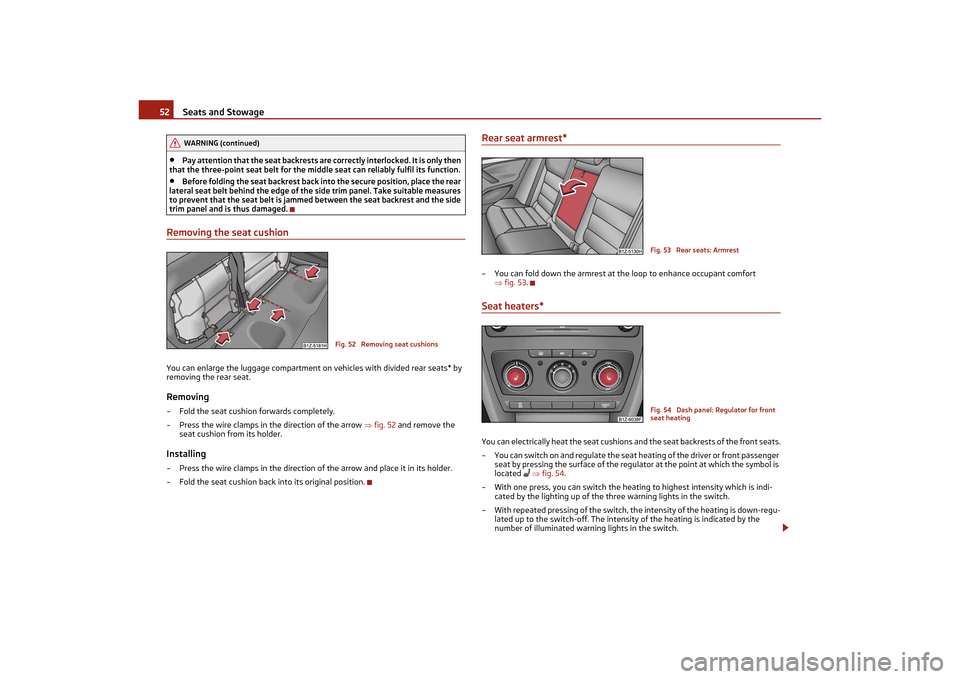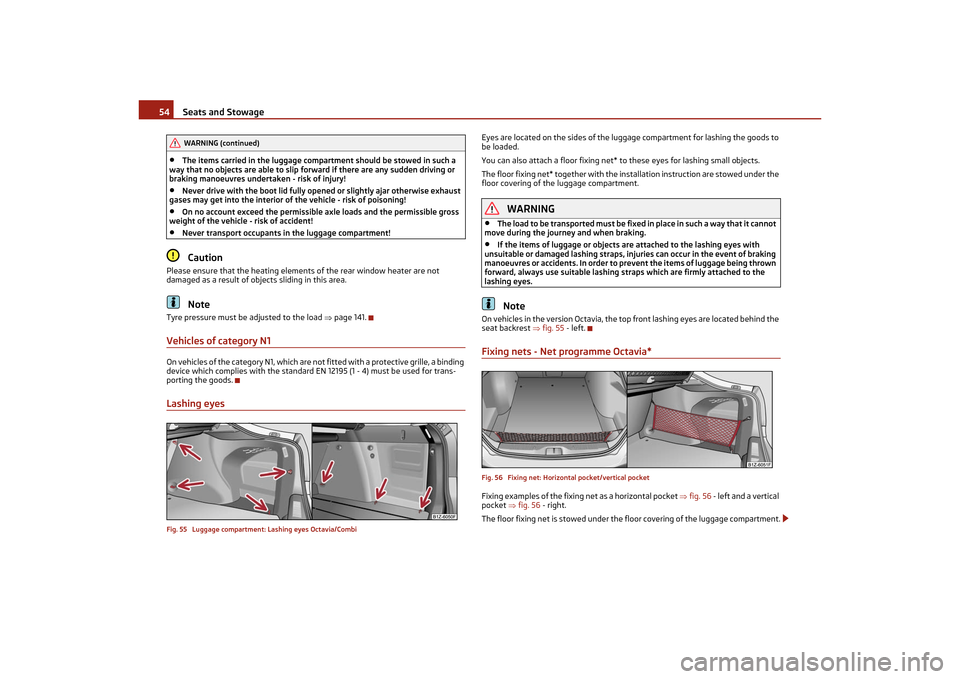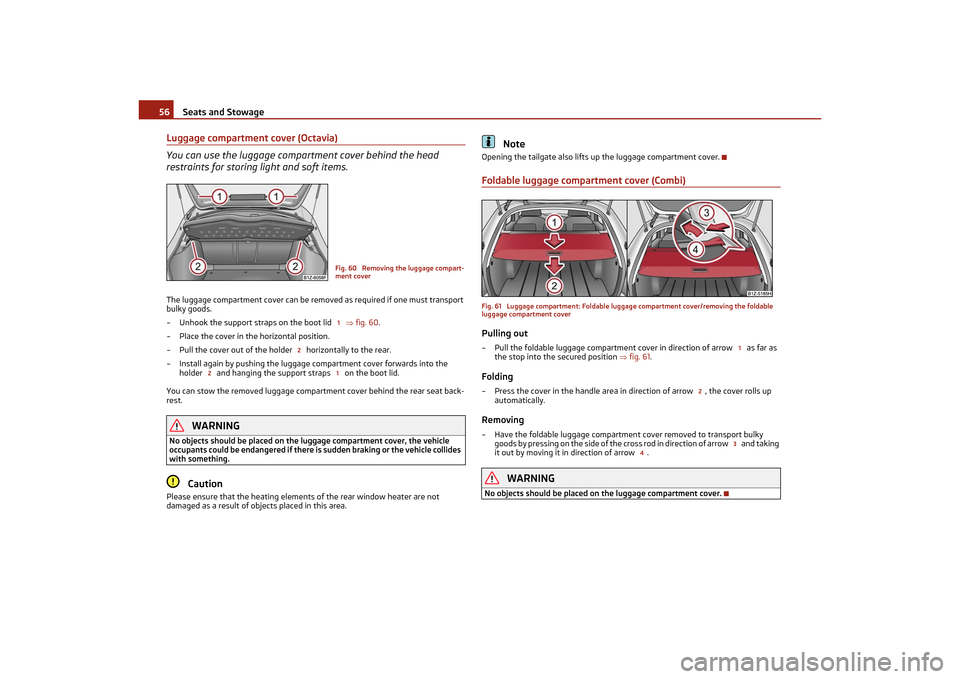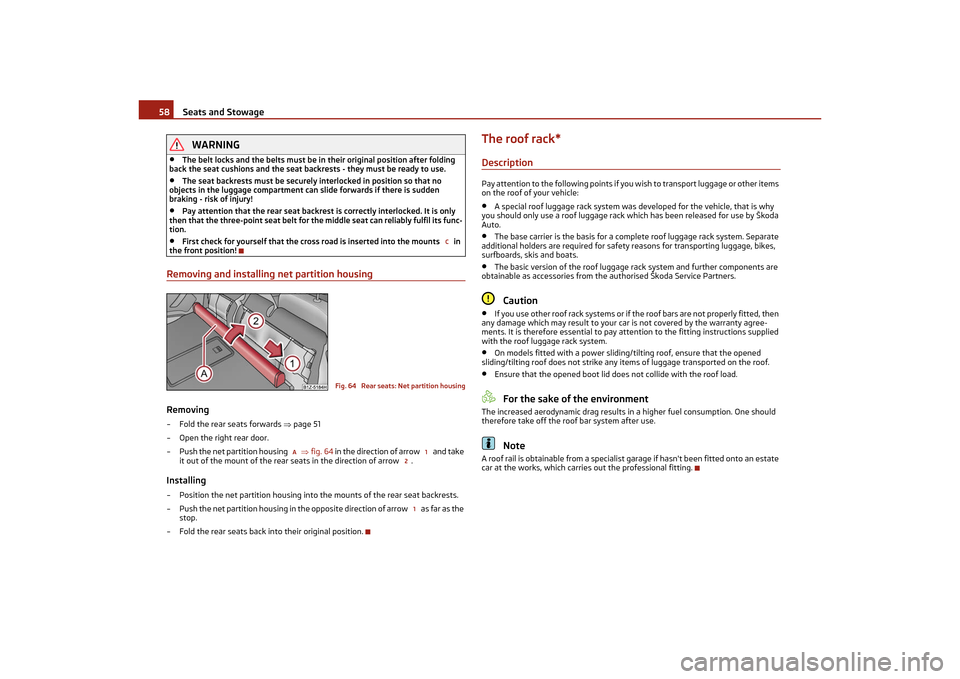2011 SKODA OCTAVIA TOUR warning
[x] Cancel search: warningPage 53 of 183

Seats and Stowage
52
•
Pay attention that the seat backrests are correctly interlocked. It is only then
that the three-point seat belt for the midd le seat can reliably fulfil its function.
•
Before folding the seat backrest back into the secure position, place the rear
lateral seat belt behind the edge of the side trim panel. Take suitable measures
to prevent that the seat belt is jammed between the seat backrest and the side
trim panel and is thus damaged.
Removing the seat cushionYou can enlarge the luggage compartment on vehicles with divided rear seats* by
removing the rear seat.Removing– Fold the seat cushion forwards completely.
– Press the wire clamps in the direction of the arrow fig. 52 and remove the
seat cushion from its holder.Installing– Press the wire clamps in the direction of the arrow and place it in its holder.
– Fold the seat cushion back into its original position.
Rear seat armrest*– You can fold down the armrest at th e loop to enhance occupant comfort
fig. 53 .Seat heaters*You can electrically heat the seat cushions and the seat backrests of the front seats.
– You can switch on and regulate the seat heating of the driver or front passenger seat by pressing the surface of the regulator at the point at which the symbol is
located
fig. 54 .
– With one press, you can switch the heating to highest intensity which is indi- cated by the lighting up of the three warning lights in the switch.
– With repeated pressing of the switch, th e intensity of the heating is down-regu-
lated up to the switch-off. The intensit y of the heating is indicated by the
number of illuminated warning lights in the switch.
WARNING (continued)
Fig. 52 Removing seat cushions
Fig. 53 Rear seats: ArmrestFig. 54 Dash panel: Regulator for front
seat heating
s2lk.2.book Page 52 Monday, April 18, 2011 7:41 AM
Page 54 of 183

Seats and Stowage53
Using the system
Safety
Driving Tips
General Maintenance
Breakdown assistance
Technical Data
WARNING
If you or the passenger have a subdued pa in and/or temperature sensitivity, e.g.
through medication, paralysis or because of chronic illness (e.g. diabetes), we
recommend not to use the seat heating at al l. This can lead to burns on the back,
the posterior and the legs which are difficult to heal. If the seat heating is used,
we recommend to make regular breaks in your journey when driving long
distances, so that in specific cases as mentioned above the body can recuperate
from the stress of the journey. Please consult your doctor, who can evaluate
your specific condition.
Caution
•
You should not kneel on the seats or otherwise apply pressure at specific points
in order to avoid damaging the heating elements of the seat heaters.
•
Do not use the seat heating if the seats are not occupied by persons or if objects
are fastened or stored on them, for example a child seat, a bag etc. A fault of the
heating elements in the seat heating can occur.
•
Do not clean the seats moist page 125.Note
•
The seat heating should only be switched on when the engine is running. This
has a significant effect of saving on the battery capacity.
•
If the on-board voltage drops, the seat heating is switched off automatically, in
order to provide sufficient electrical energy for the engine control.
PedalsConcerning a secure depressing of the peda l, you should use only footmats from the
Škoda genuine accessories.
Operation of the pedals must not be hindered!
WARNING
•
Greater pedal distances may be needed when there is a fault in the brake
system.
•
Do not place any footmats or other additional floor coverings in the area of
the pedals in order to ensure that all the pedals can be fully depressed and are
able to return unobstructed to their initial position - risk of accident!
•
There must be no objects on the floor which could roll under the pedals. You
would then no longer be able to apply the brakes, operate the clutch or acceler-
ator - risk of accident!
luggage compartmentLoading the luggage compartmentPlease observe the following in the interest of having good handling characteristics
of your vehicle:
– Distribute the items of luggage as evenly as possible.
– Place heavy objects as far forward as possible.
– Attach the items of luggage to the lashing eyes or the fixing net* page 54.
In the event of an accident, there is such a high kinetic energy which is produced by
small and light objects that they can cause severe injuries. The magnitude of the
kinetic energy depends on the speed at which the vehicle is travelling and on the
weight of the object. The speed at which the vehicle is travelling is in this case the
more significant factor.
Example: In the event of a frontal collis ion at a speed of 50 km/h, an unsecured
object with a weight of 4.5 kg produces an energy, which corresponds to 20 times
its own weight. This means that it results in a weight of approx. 90 kg. You can
imagine the injuries that can occur, if this “bullet” is flying through the interior
compartment and hits an occupant.
WARNING
•
Stow the objects in the luggage compartment and attach them to the lashing
eyes.
•
Loose objects in the passenger compar tment can be thrown forward during
a sudden manoeuvre or in case of an ac cident and can injure the occupants or
other oncoming traffic. This risk is still increased, if the objects which are flying
around are hit by a deployed airbag. In this case, the objects which are thrown
back can injure th e occupants - hazard.
•
Please note that the handling properti es of your vehicle may be affected
when transporting heavy objects as a result of the displacement of the centre of
gravity. The speed and style of driv ing must be adjusted accordingly.WARNING (continued)
s2lk.2.book Page 53 Monday, April 18, 2011 7:41 AM
Page 55 of 183

Seats and Stowage
54
•
The items carried in the luggage compartment should be stowed in such a
way that no objects are able to slip fo rward if there are any sudden driving or
braking manoeuvres undert aken - risk of injury!
•
Never drive with the boot lid fully opened or slightly ajar otherwise exhaust
gases may get into the interior of the vehicle - risk of poisoning!
•
On no account exceed the permissible axle loads and the permissible gross
weight of the vehicle - risk of accident!
•
Never transport occupants in the luggage compartment!Caution
Please ensure that the heating elements of the rear window heater are not
damaged as a result of objects sliding in this area.
Note
Tyre pressure must be adjusted to the load page 141.Vehicles of category N1On vehicles of the category N1, which are no t fitted with a protective grille, a binding
device which complies with the standard EN 12195 (1 - 4) must be used for trans-
porting the goods.Lashing eyesFig. 55 Luggage compartment: Lashing eyes Octavia/Combi
Eyes are located on the sides of the lugg age compartment for lashing the goods to
be loaded.
You can also attach a floor fixing net* to these eyes for lashing small objects.
The floor fixing net* together with the in stallation instruction are stowed under the
floor covering of the luggage compartment.
WARNING
•
The load to be transported must be fixe d in place in such a way that it cannot
move during the jour ney and when braking.
•
If the items of luggage or objects ar e attached to the lashing eyes with
unsuitable or damaged lashing straps, injuries can occur in the event of braking
manoeuvres or accidents. In order to pr event the items of luggage being thrown
forward, always use suitable lashing st raps which are firmly attached to the
lashing eyes.Note
On vehicles in the version Octavia, the to p front lashing eyes are located behind the
seat backrest fig. 55 - left.Fixing nets - Net programme Octavia*Fig. 56 Fixing net: Horizontal pocket/vertical pocketFixing examples of the fixing net as a horizontal pocket fig. 56 - left and a vertical
pocket fig. 56 - right.
The floor fixing net is stowed under the floor covering of the luggage compartment.
WARNING (continued)
s2lk.2.book Page 54 Monday, April 18, 2011 7:41 AM
Page 56 of 183

Seats and Stowage55
Using the system
Safety
Driving Tips
General Maintenance
Breakdown assistance
Technical Data
WARNING
The whole strength of the net makes it possible to load the pocket with objects
of up to 1.5 kg in weight. Heavy objects ar e not secured sufficiently - risk of injury
and net damage!
Caution
Do not place any objects with sharp edges in the nets - risk of net damage.Fixing nets - Ne t programme Combi*Fig. 57 Fixing net: Vertical pocket /division of the luggage compartmentFixing examples of the fixing net as pocket fig. 57 - left and as division of the
luggage compartment fig. 57 -right.
The floor fixing net is stowed under the floor covering of the luggage compartment.
WARNING
The whole strength of the net makes it possible to load the pocket with objects
of up to 1.5 kg in weight. Heavy objects ar e not secured sufficiently - risk of injury
and net damage!
Caution
Do not place any objects with sharp edges in the nets - risk of net damage.
Folding hooks (Combi)Folding hooks for attaching small items of lu ggage, such as bags etc., are provided
on both sides of the luggage compartment fig. 58 .
An item of luggage weighing up to 10 kg can be attached to the hook.Fixing floor covering of the luggage compartmentFig. 59 Luggage compartment: Fixing of the floor covering Octavia/CombiThere is a loop (Octavia) or there are hook s (Combi) located on the floor covering of
the luggage compartment. You can fix the raised floor cover with a hook to the
luggage compartment cover (Octavia) fig. 59 - left, as if one needs to reach the
spare wheel or to the frame of the boot lid (Combi) fig. 59 - right.
Fig. 58 Luggage compartment: folding
hooks
s2lk.2.book Page 55 Monday, April 18, 2011 7:41 AM
Page 57 of 183

Seats and Stowage
56
Luggage compartment cover (Octavia)
You can use the luggage compartment cover behind the head
restraints for storing light and soft items.The luggage compartment cover can be removed as required if one must transport
bulky goods.
– Unhook the support straps on the boot lid fig. 60 .
– Place the cover in the horizontal position.
– Pull the cover out of the holder horizontally to the rear.
– Install again by pushing the luggage compartment cover forwards into the
holder and hanging the suppor t straps on the boot lid.
You can stow the removed luggage compartment cover behind the rear seat back-
rest.
WARNING
No objects should be placed on the luggage compartment cover, the vehicle
occupants could be endangered if there is sudden braking or the vehicle collides
with something.
Caution
Please ensure that the heating elements of the rear window heater are not
damaged as a result of objects placed in this area.
Note
Opening the tailgate also lifts up the luggage compartment cover.Foldable luggage compartment cover (Combi)Fig. 61 Luggage compartment: Foldable lugg age compartment cover/removing the foldable
luggage compartment coverPulling out– Pull the foldable luggage compartment cover in direction of arrow as far as the stop into the secured position fig. 61 .Folding– Press the cover in the handle area in direction of arrow , the cover rolls up
automatically.Removing– Have the foldable luggage compartment cover removed to transport bulky
goods by pressing on the side of the cros s rod in direction of arrow and taking
it out by moving it in direction of arrow .
WARNING
No objects should be placed on the luggage compartment cover.
Fig. 60 Removing the luggage compart-
ment cover1
2
2
1
1
2
3
4
s2lk.2.book Page 56 Monday, April 18, 2011 7:41 AM
Page 58 of 183

Seats and Stowage57
Using the system
Safety
Driving Tips
General Maintenance
Breakdown assistance
Technical Data
Net partition* (Combi)Use the net partition be hind the rear seatsFig. 62 Folding down the storage compartment cover/pulling out the net partitionPulling out– Fold down the storage compartmen t cover behind the rear seats fig. 62 - left.
– Pull the net partition at the bracket out of the housing in direction of the holders .
– Insert the cross rod into one of the mo unts and push the cross rod forwards.
– In the same way, fix the cross rod to the other side of the vehicle, mount .
– Fold the storage compartment cover downwards.Folding– Fold down the storage compartmen t cover behind the rear seats fig. 62 .
– Pull the cross rod back slightly, first on the one side then on the other side and
take the cross rod out of the mounts .
– Hold the cross rod in such a way that the net partition can roll up slowly and
without damage into housing .
– Fold the storage compartment cover downwards.
If you wish to use the entire luggage compartment, you can remove the luggage
compartment cover page 56, fig. 61 .
WARNING
•
First check for yourself that the cross road is inserted into the mounts in
the front position!
•
Pay attention that the rear seat backrest is correctly interlocked. It is only
then that the three-point seat belt for the middle seat can reliably fulfil its
function.
Using the net partition behind the front seatsPulling out– Fold the rear seats forwards page 51
– Pull the net partition net at the plate out of the housing fig. 63 .
– Insert the cross rod into the mount first on the one side and push the cross rod forwards.
– In the same way, fix the cross rod to the other side of the vehicle, mount .Folding–Pull the cross rod back slightly, first on the one side then on the other side and
take the cross rod out of the mounts fig. 63 .
– Hold the cross rod in such a way that th e net partition can roll up slowly and
without damage into housing .
– Fold the rear seats back into their original position.
A
B
C
C
C
C
B
C
Fig. 63 Pull out the net partition
A
B
C
C
C
B
s2lk.2.book Page 57 Monday, April 18, 2011 7:41 AM
Page 59 of 183

Seats and Stowage
58WARNING
•
The belt locks and the belts must be in their original position after folding
back the seat cushions and the seat backrests - they must be ready to use.
•
The seat backrests must be securely interlocked in position so that no
objects in the luggage compartment can slide forwards if there is sudden
braking - risk of injury!
•
Pay attention that the rear seat backrest is correctly interlocked. It is only
then that the three-point seat belt for the middle seat can reliably fulfil its func-
tion.
•
First check for yourself that the cross road is inserted into the mounts in
the front position!
Removing and installing net partition housingRemoving– Fold the rear seats forwards page 51
– Open the right rear door.
– Push the net partition housing fig. 64 in the direction of arrow and take
it out of the mount of the rear seats in the direction of arrow .Installing– Position the net partition housing into the mounts of the rear seat backrests.
– Push the net partition housing in the opposite direction of arrow as far as the stop.
– Fold the rear seats back in to their original position.
The roof rack*DescriptionPay attention to the following points if you wish to transport luggage or other items
on the roof of your vehicle:•
A special roof luggage rack system was developed for the vehicle, that is why
you should only use a roof luggage rack which has been released for use by Škoda
Auto.
•
The base carrier is the basis for a complete roof luggage rack system. Separate
additional holders are required for safety reasons for transporting luggage, bikes,
surfboards, skis and boats.
•
The basic version of the roof luggage ra ck system and further components are
obtainable as accessories from the authorised Škoda Service Partners.Caution
•
If you use other roof rack systems or if th e roof bars are not properly fitted, then
any damage which may result to your car is not covered by the warranty agree-
ments. It is therefore essential to pay atte ntion to the fitting instructions supplied
with the roof luggage rack system.
•
On models fitted with a power sliding/tilting roof, ensure that the opened
sliding/tilting roof does not strike any items of luggage transported on the roof.
•
Ensure that the opened boot lid do es not collide with the roof load.For the sake of the environment
The increased aerodynamic drag results in a higher fuel consumption. One should
therefore take off the roof bar system after use.
Note
A roof rail is obtainable from a specialist garage if hasn't been fitted onto an estate
car at the works, which carries out the professional fitting.
C
Fig. 64 Rear seats: Net partition housing
A
1
21
s2lk.2.book Page 58 Monday, April 18, 2011 7:41 AM
Page 60 of 183

Seats and Stowage59
Using the system
Safety
Driving Tips
General Maintenance
Breakdown assistance
Technical Data
Lashing points (Octavia)Perform the assembly and the disassembly according to the attached instructions.
Note
•
If you have any questions, please contact a specialist garage.
•
The figure is not valid for an estate car.
Roof loadDistribute weight evenly over the roof luggage rack system. The maximum permis-
sible roof load (including roof rack system) of 75 kg and the maximum permissible
total weight of the vehicle should not be exceeded.
You cannot make full use of the permissible roof load if you use a roof luggage rack
system with a lower load carrying capaci ty. The load transported on the roof
luggage rack system must not exceed the we ight limit which is stated in the fitting
instructions.
WARNING
•
The items which you transport on the roof bar system must be reliably
attached - risk of accident!
•
You must on no account exceed the pe rmissible roof load, the permissible
axle loads and the permissible gross weight of your vehicle - risk of accident!
•
Please note that the handling properties of your vehicle change when you
transport heavy or bulky items on the roof bar system as a result of the displace-
ment of the centre of gravity and the incr eased wind attack area - risk of acci- dent! You must absolutely
adapt your style of driving and the speed of the
vehicle to the specific circumstances.
Cup holderCup holder in front centre consoleYou can place two cups or beverage cans into the recesses fig. 66 .
WARNING
•
Do not place any hot beverages into the cup holder. If the vehicle moves, the
hot beverages may spill - risk of scalding!
•
Do not use any cups or beakers which are made of brittle material (e.g. glass,
porcelain). You might be injured by them in the event of an accident.Caution
Do not open the beverages in the cup holder while driving. They may spill when
braking and while doing so damage the vehicle.
Fig. 65 Attachment points for base roof
carrier
WARNING (continued)
Fig. 66 Front centre console: Cup holder
s2lk.2.book Page 59 Monday, April 18, 2011 7:41 AM